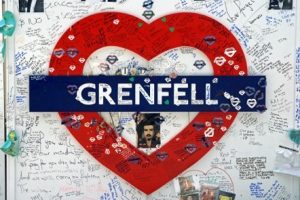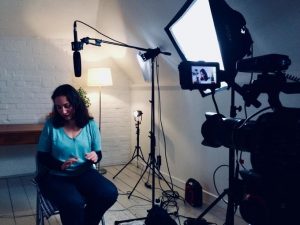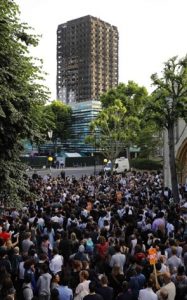In the Shadow of Grenfell: Silence speaks louder than words
This blog was published by Eloise Jones, second year BSc International Disaster Management and Humanitarian Response student at the Humanitarian and Conflict Response Institute (HCRI). It was published due to being an assessment piece of the highest calibre amongst the cohort in the Disasters and Development course module. The blog relates to the 2017 Grenfell tower fire in North London, which killed more than 70 people.
On the 14th June 2017 in the Royal Borough of Kensington and Chelsea, a building burned[1]. In that year, London Fire Brigade reported 19,863 fires in the city[2], but this one was different. The fire itself was devastating; killing 72 people and leaving hundreds without a home[3]. It was an image we all saw on the news: I remember waking up that morning to my TV screen showing a building engulfed in flames; when I walked home from college that afternoon I came home to the same image. The fire burned for over 60 hours. Three years on, Grenfell remains “one of the UK’s worst modern disasters”[4]. Its short-term impacts on community, and its long-term impacts on changing narratives that question the dark side of British politics, is why this disaster has had such an impact.
The struggles communities experience during and in the aftermath of disasters can lead to either the strengthening or the regression of said community[5]. In the case of Grenfell, it has led to the strengthening of a community within a borough which is heavily divided: by income, class, religion, race. Individuals provided shelter, food and clothing for the survivors of the fire; religious groups even provided support to those in the area. For example, the local Islam community invited everyone to join them in breaking the fast of Ramadan together[6]. The community began to flourish in bringing people together. Despite social divides – the Royal Borough of Kensington and Chelsea has the largest income inequality in London[7] – the short-term effect Grenfell had on the community is that it united them. But this arguably positive impact of Grenfell was not just seen in the community; it was also – to an extent – seen in British parliament.
Eight days later, 5 miles away, and in a different building (one which, as it happens, we celebrate every year for not having been destroyed), Theresa May delivered a speech. She promised that the government would make a “lasting commitment… to supporting the families affected, long after the television cameras have gone.”[8] Her speech – delivered to a group of people whose lives were so very different to the lives of those in Grenfell – sounded like a promise for change. It sounded as though Grenfell had not just influenced community, but also the government. Would this be a time where the government began to listen to the working class and minorities? Would Grenfell unite a divided nation, not just a divided community?
The tie between how Grenfell affected both community and government in the immediate aftermath is illustrated in the government’s support for, and the community’s push for a public inquiry: in order to find out what happened, who was to blame, and ask how this could be prevented in the future[9]. It seems that in the short term, the disaster influenced the government as they began to recognise a need to provide long-term help, as mentioned in Theresa May’s speech. However, whilst May’s speech was filled with promising pledges, the fact is that in the long term they were not kept. As we will see, then: the impact of Grenfell digs far deeper than these short-term impacts. It has illustrated how the dark history of British politics – whereby minorities are side-lined and discriminated against – is still present today.
It has been over two years since the fire, and since then, there has been more and more discourse emerging which explains the disaster as largely the result of the inequalities rooted in the British system. The area of Grenfell has been considered an “‘internal colony’, an area where ‘Others’ have been confined in Britain”[10]. This narrative reflects how Britain’s history of racial and colonial ideologies is ongoing. In September 2019, a series of workshops were conducted by lecturer Natalie Ohana which invited survivors and the bereaved to discuss their experiences of the Grenfell Tower Inquiry. They talked about how institutionalised discrimination (regarding class, religion, race) was the root cause of the disaster. Following the discussion, Ohana stated that Grenfell Tower “cannot be understood without looking into discrimination”[11]; yet in spite of this fact, discrimination was not included in the terms of reference for phase one of the inquiry[12]. Thus, whilst in the short-term, it seemed as though the government was trying to change, in reality they have continued to ignore these people. Their silence in the longer term on the matter of the Grenfell disaster is reflective of the state’s indifference toward those who are not white, British, and middle class. In short: their silence reflects the institutionalised discrimination against those the government consider to be “Others”[13] in society.
This relative silence in the two and a half years since Grenfell is more telling than the promises made by the government in the wake of the disaster. This silence tells the British public that the sinister past of Britain is still present today: the long-term impact of Grenfell is thus that it has exposed a dark corner of British politics and opened a conversation about it. Other examples of the institutional discrimination which Grenfell has shed light on continue even as I write this; the UK introducing harsher immigration laws[14]; racism reported even within the government[15]; the Windrush Scandal[16]. The community united in the immediate aftermath of the disaster is still continuing to strive to be heard (via the Grenfell Tower Inquiry and community organisations like Justice for Grenfell), but in today’s climate it is questionable whether the community has the ability to change a system which appears to be unflinchingly discriminatory.
The building which I saw on TV that day no longer burns. Instead, it stands charred and black and silent. It stands tall and scarred like the community which continues to fight. It stands silent like the government, and empty like their promises.
References
[1] BBC News (2020) Grenfell Tower: What happened, Available at: https://www.bbc.co.uk/news/uk-40301289 (Accessed: 27th February 2020).
[2] London Datastore (2020) London Fire Brigade Incident Records, Available at: https://data.london.gov.uk/dataset/london-fire-brigade-incident-records (Accessed: 27th February 2020).
[3] BBC News (2020) Grenfell Tower: What happened, Available at: https://www.bbc.co.uk/news/uk-40301289 (Accessed: 27th February 2020).
[4] BBC News (2020) Grenfell Tower: What happened, Available at: https://www.bbc.co.uk/news/uk-40301289 (Accessed: 27th February 2020).
[5] Stein, B. (1996) ‘Community Reactions to Disaster: An Emerging Role for the School Psychologist’, Sage Journals, 18(2), pp. 97 [Online]. Available at: https://www.palermo.edu/cienciassociales/publicaciones/pdf/Psico1/1%20PSICO%20008.pdf(Accessed: 27th February 2020).
[6] Charles, M. (2019) ‘ComeUnity and Community in the Face of Impunity’, in Bulley, D. et al (ed.) After Grenfell: Violence, resistance and response. UK: Pluto Press, pp. 176.
[7] Trust for London (2020) Kensington and Chelsea: Poverty and inequality data for Kensington & Chelsea, Available at: https://www.trustforlondon.org.uk/data/boroughs/kensington-and-chelsea-poverty-and-inequality-indicators/ (Accessed: 28th February 2020).
[8] Gov.uk (2020) PM Commons statement on Grenfell Tower: 22 June 2017, Available at: https://www.gov.uk/government/speeches/pm-commons-statement-on-grenfell-tower-22-june-2017 (Accessed: 26th February 2020).
[9] Institute for Government (2020) Public Inquiries, Available at: https://www.instituteforgovernment.org.uk/explainers/public-inquiries (Accessed: 26th February 2020).
[10] Charles, M. (2019) ‘ComeUnity and Community in the Face of Impunity’, in Bulley, D. et al (ed.) After Grenfell: Violence, resistance and response. UK: Pluto Press, pp. 168.
[11] Institutional Violence (2020). The Grenfell Tower Inquiry Must Investigate Institutional Discrimination [Youtube]. Available at: https://www.youtube.com/watch?time_continue=535&v=flqI7Xx3oDE&feature=emb_logo (Accessed: 28th February 2020).
[12] Institutional Violence (2020). The Grenfell Tower Inquiry Must Investigate Institutional Discrimination [Youtube]. Available at: https://www.youtube.com/watch?time_continue=535&v=flqI7Xx3oDE&feature=emb_logo (Accessed: 28th February 2020).
[13] Charles, M. (2019) ‘ComeUnity and Community in the Face of Impunity’, in Bulley, D. et al (ed.) After Grenfell: Violence, resistance and response. UK: Pluto Press, pp. 168.
[14] Goodfellow, M. (2020) ‘There’s Nothing ‘Sensible’ about Priti Patel’s Heartless Immigration Proposal’, The Guardian, 19th February, (online)
[15] Walker, P. (2020) ‘Most BAME MPs have experienced racism in parliament, study finds’, The Guardian, 17th February, (online)
[16] BBC News (2020) Windrush Scandal, Available at: https://www.bbc.co.uk/news/topics/c9vwmzw7n7lt/windrush-scandal (Accessed: 28th February 2020).
17 EasternEye. Volunteers prepare supplies for people affected by the Grenfell Tower block which was destroyed in a fire. June 20, 2017. London. https://www.easterneye.biz/volunteers-charities-come-together-support-grenfell-tower-survivors/
18 ChiralJon. Grenfell Tribute. July 13, 2018. London. https://www.flickr.com/photos/69057297@N04/42484928645/
19 Preston Street Films. With the second phase of the Grenfell Inquiry beginning soon, we’re working with University of Exeter’s Law Lecturer Natalie Ohana on issues connecting institutional discrimination to the Grenfell Inquiry. January 17, 2020. https://twitter.com/PrestonStFilms/status/1218119293466030080
20 AFP. The shell of Grenfell Tower hangs over protesters gathering at Notting Hill Methodist Church. June 17, 2017. London. https://www.telegraph.co.uk/news/2017/06/16/london-fire-latest-updates-grenfell-tower-fire-victims/






0 Comments